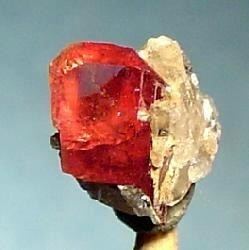Category Inosilicate Strunz classification 9.DK.05 Space group P1 | Formula(repeating unit) (Li,Na)Mn4Si5O14(OH) Crystal system Triclinic | |
 | ||
Crystal class Pinacoidal (1)(same H-M symbol) | ||
Nambulite is a lithium bearing manganese silicate mineral with formula: (Li,Na)Mn4Si5O14(OH). It is named after the mineralogist, Matsuo Nambu (born 1917) of Tohoko University, Japan, who is known for his research in manganese minerals. The mineral was first discovered in the Funakozawa Mine of northeastern Japan, a metasedimentary manganese ore.
Nambulite is formed from the reaction between a hydrothermal solution and rhodonite, and commonly creates veins in the host rock. Other than a collector’s gem, however, it has little economic value.
It belongs to the triclinic-pinacoidal crystal system (or triclinic-normal), meaning that it has three axes of unequal length (a, b, c), all intersecting at oblique angles with each other (none of the angles are equal to 90°). It belongs to the crystal class 1, meaning that any point on the crystal that is rotated 360° and then completely inverted will meet with an equal (but opposite) point on the crystal (see centrosymmetry). It’s space group is P 1.
The three axes (a, b, c) have different indices of refraction, na=1.707, nb=1.710, nc=1.730. The index of refraction (RI) can be defined as n = cair/cmineral, where “n” is the index of refraction and “c” is the speed of light. The maximum birefringence is .023, the difference between the highest (nc=1.730) and lowest (na=1.707) indices of refraction within the mineral.
In a medium with an index of refraction equaling 1.53, Nambulite has a calculated relief of 1.71-1.73, giving it a moderate to high relief. Relief is a measure of the difference between the index of refraction of the mineral and that of the medium (often Canada balsam or other epoxy with an RI of around 1.53-1.54).
Nambulite is an anisotropic crystal, where the velocity of light that passes through the crystal varies depending on the crystallographic direction. In contrast, an isotropic crystal includes all isometric crystals, and the velocity of light is equal in all directions. The mineral exhibits slight pleochroism. Pleochroism is an optical property observed when the mineral is viewed under the microscope in plane polarized light, and when it the stage of the microscope is rotated the observed colors change. The color change is due to different wavelengths being absorbed in different directions, and the color of the mineral depends on the crystallographic orientation.
